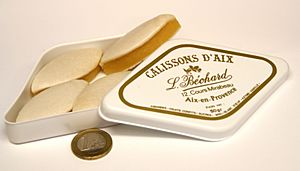Calisson facts for kids
 |
|
| Alternative names | canisson, canissoun |
|---|---|
| Type | Confectionery |
| Place of origin | France |
| Serving temperature | cold |
| Main ingredients | candied fruit (especially melons and oranges), almond meal or flour, fondant |
Calissons are a special French candy. They are made from a smooth, light yellow paste. This paste has candied fruits, especially melons and oranges, mixed with ground almonds. On top, there's a thin layer of sweet royal icing.
Calissons feel a bit like marzipan. But they have a stronger, fruity taste, especially of melon. They are often shaped like an almond. Each candy is usually about five centimeters (two inches) long. Calissons are famous from the town of Aix-en-Provence in France. Most of the world's Calissons are still made in the Provence area.
The Sweet History of Calissons
The Calisson candy likely started in medieval Italy. One of the first times Calissons were mentioned was in 1275. This was in a book called Chronicle of the Venetians. An older text from the 1100s used the word calisone. It described a cake made with almonds and flour.
Another candy similar to Calissons is kalitsounia. This treat was made with marzipan, nuts, and spices. Spices like cinnamon and cloves were often used. You could find kalitsounia in places where the Venetians lived, like Crete.
Some people think Calissons came to Provence in the mid-1400s. This was around the second wedding of King René of Anjou. Others believe the modern Calisson arrived later, in the 1500s. This was when almonds became a common crop in Aix-en-Provence.
Protecting the Calisson Name
The special status of Calissons has been protected in France since 1991. This means that local candy makers must follow strict rules. These rules ensure the Calissons are made in a traditional way. This protection only applies within France.
For 14 years, French Calisson makers tried to get international rights. They wanted to protect the Calisson name worldwide. But they could not agree on the exact ingredients for the recipe. To stop foreign companies from using the Calisson d'Aix name, they asked for a Protected Geographical Indication (PGI) in 2015. But it was already too late.
In 2016, the French makers started a big legal fight. A Chinese company had already registered the candy's name in China. They called it "Kalisong." In 2017, the French union finally won the case. They successfully stopped the Chinese trademark registration. This helped protect the traditional Calisson name.
See also

- In Spanish: Calisson para niños

